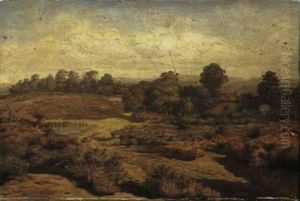Rosa Brett Paintings
Rosa Brett was a Victorian artist born into a creative and intellectual family in 1829. She was the younger sister of the well-known Pre-Raphaelite painter John Brett, and her artistic inclinations were nurtured in an environment that valued art and culture. Despite the constraints placed on women in the Victorian era, Rosa pursued her passion for painting, although she did not achieve the same level of fame as her brother.
Trained primarily by her brother, Rosa Brett developed a style that was influenced by the Pre-Raphaelite Brotherhood, a group of English painters, poets, and critics founded in 1848. The Brotherhood aimed to reform art by rejecting what it considered the mechanistic approach first adopted by the Mannerist artists who succeeded Raphael and Michelangelo. Their work featured intense colors, attention to detail, and complex compositions, which often drew inspiration from medieval and early Renaissance art.
Rosa's work was characterized by its delicate handling, attention to botanical detail, and serene compositions. She often painted landscapes and was known for her fine botanical work. Unfortunately, her career was somewhat overshadowed by her brother's success, and as a woman artist, her opportunities to exhibit and sell her work were limited. She did, however, exhibit with the Royal Academy on a few occasions and was associated with other female artists of the time who were struggling for recognition and equality in the art world.
Brett's work was not widely known during her lifetime and has only been sporadically recognized in art historical discourse since her death in 1882. Nevertheless, she remains a figure of interest in the study of women artists in the Victorian era, and her surviving works provide insight into the role and challenges faced by female painters during this period. Her paintings can be seen as an embodiment of the Pre-Raphaelite principles and aesthetic, as well as a testament to the quiet perseverance of women artists in the 19th century.










